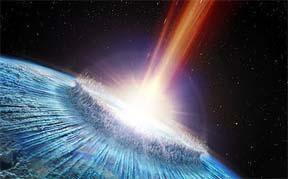A cluster of at least three asteroids between 20 and 50 kilometres across colliding with Earth over 3.2 billion years ago caused a massive change in the structure and composition of the earth's surface, according to new research by
Australian National University earth scientists.
According to Dr Andrew Glikson and Mr John Vickers from the
Department of Earth and Marine Sciences at ANU, the impact of these asteroids triggered major earthquakes, faulting, volcanic eruption and deep-seated magmatic activity and interrupted the evolution of parts of the Earth's crust.

Impact! (Courtesy: Thinkquest Library)The identification of impact ejecta — materials ejected by the hitting asteroid — is based on unique minerals and chemical and isotopic compositions indicative of extraterrestrial origin, including
Iridium anomalies.
The impact ejecta from the Barberton region in the eastern Transvaal (of Australia) indicate the formation of impact craters several hundred kilometres in diameter in oceanic regions of the earth, analogous to the lunar maria basins (large dark impressions on the surface of the moon). The seismic effects of the impacts included vertical block movements, exposure of deep-seated granites and onset of continental conditions on parts of the earth surface:).